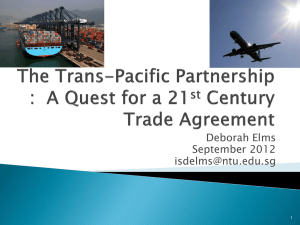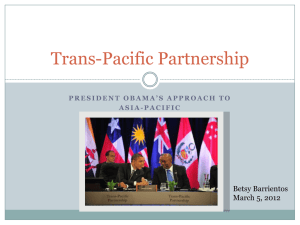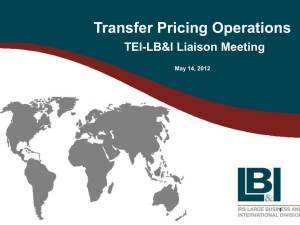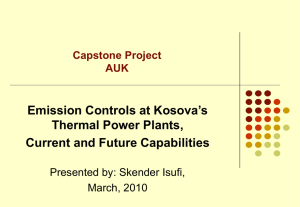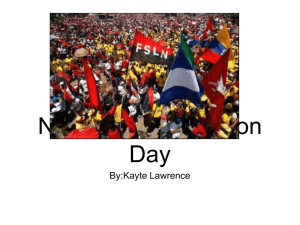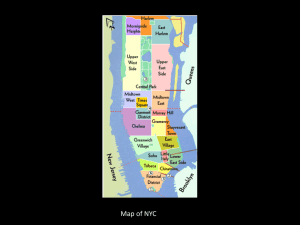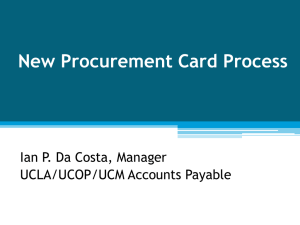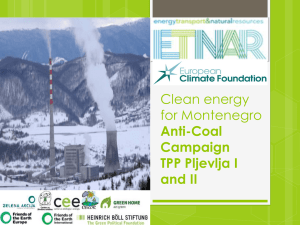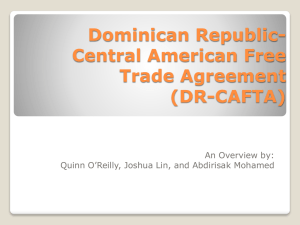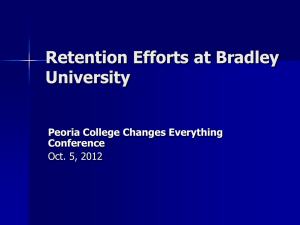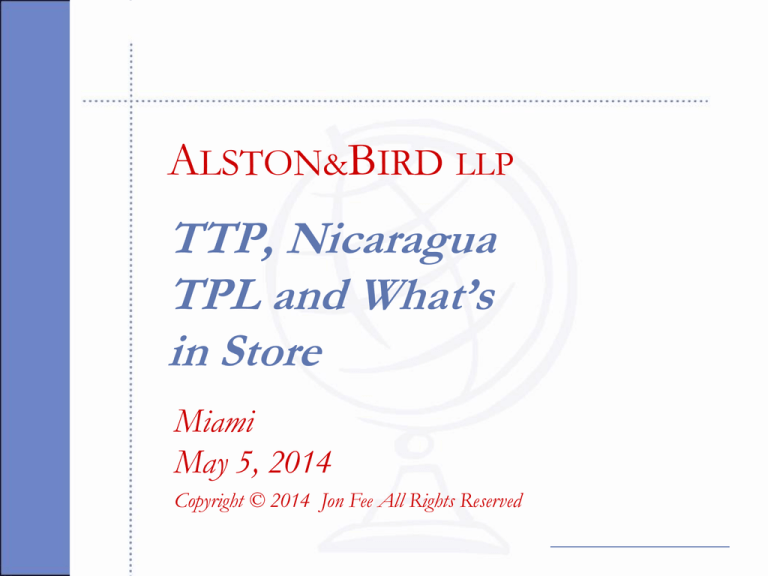
ALSTON&BIRD LLP
TTP, Nicaragua
TPL and What’s
in Store
Miami
May 5, 2014
Copyright © 2014 Jon Fee All Rights Reserved
Items of interest
• Trans-Pacific Partnership
(TPP)
• Trade Promotion Authority
(TPA)
• Textile and apparel features
• Timing of TPA and TPP
• Nicaragua TPL extension
• The trade and political
context
TPP generally
• Australia, Brunei, Canada, Chile,
Japan, Malaysia, Mexico, New
Zealand, Peru, Singapore, the
United States and Vietnam
• “Comprehensive,”
“ambitious,” “high-standard,”
“21st-century” FTA
• US “pivot,” “rebalancing”
toward Asia
• 40 percent of US goods trade
Selected TPP rules issues
•
•
•
•
•
•
•
•
•
•
Intellectual property rights
Rules of origin (e.g., yarn-forward)
Technical barriers to trade
Transparency in health care technology
and pharmaceuticals
Foreign investment
Competition
Trade remedies (ADD, CVD,
safeguards)
Labor (association, collective bargaining,
forced labor, child labor, discrimination)
Environment (e.g., logging, fisheries,
endangered species, multilateral
environmental agreements, green
technology)
State-owned enterprises (SOEs) in
Vietnam, Malaysia and Singapore
Selected TPP market access issues
• Bilateral vs. multilateral
negotiations
• Tariff elimination and staging
• Services (insurance, banking,
legal, telecommunications,
express delivery, e-commerce)
• Government procurement (Buy
American, state procurement)
• Agriculture (dairy, sugar, cotton,
tobacco, geographical
indications and sanitary and
phytosanitary standards)
• Textiles, apparel and footwear
Vietnamese apparel and TPP
TPP and Central America
TPP textile and apparel issues
• “Yarn-forward” vs. “change in tariff
heading” (CTH) or “regional value
content” (RVC)
• “Short supply” (permanent and
temporary) and SSL proposals
• Immediate or “staged” tariff
elimination
• Safeguard and enforcement
provisions
• Cumulation (among members or
with other FTAs)
• Alternative to other pre-existing
FTAs with members
Yarn forward
• The TPP apparel origin rule will
almost certainly be “yarn
forward” for most apparel
• Preferential treatment will be
allowed if the component
determining classification is
knitted or woven in TPP
countries from yarn spun or
extruded in TPP countries and
the apparel is cut or knit to
shape and assembled in TPP
countries
What form of preferential treatment?
• Central America,
Colombia, Peru, Panama
and Korea got duty free
treatment right away
• But remember Mexico,
under NAFTA?
• For some NAFTA
garments, duties were
phased out in stages over 5
or more years
• Expect the same for TPP
X basket
• United States has proposed
an “X basket” of sensitive
apparel classifications from
Vietnam
• Duty rates on X basket
would be cut by some
percentage (35 to 50
percent?) for an initial period
of several years before they
would be reduced to Free
X basket
• X basket will likely cover
shirts, sweaters and trousers
of cotton and synthetic
fiber
• Importers from TPP
countries that already have
FTAs with the United
States (Australia, Canada,
Mexico and Peru) could
continue to use Free rates
available under those FTAs
rather than the X basket
rates
TPP short supply
• Not like CAFTA – more like
the original NAFTA (but
without NAFTA’s
cumbersome, little-used short
supply feature that theoretically
allows new designations)
• Remember how some single
transformation features were
written into NAFTA for
selected garments of hard-tofind fabrics? That’s how TPP
will work
TPP short supply
• Interested persons were invited
to suggest (or oppose) short
supply fabrics and yarns on a
website operated by USTR and
OTEXA
• Some non-sensitive apparel
articles will be temporarily
(three years) or permanently
duty-free (or eligible for
reduced duty rates) even though
they incorporate foreign, non
TPP fabrics or yarns
TPP short supply
• The list of short supply
apparel will be fixed by the
terms of the TPP
• Interested persons won’t be
allowed to request new
designations after the TPP
effective date as they are
able to do under CAFTA
• Mexico (a TPP member),
seeks to shorten the list to
protect its access to the U.S.
market
TPP short supply
• U.S. policy perpetuates two
myths
• First (remember the quota
system?) temporary short supply
features will give U.S. and TPP
industries breathing room to
catch up and start producing
inputs and apparel they don’t
make now
• Second, CAFTA short supply is
unsuccessful, so they won’t allow
it again in TPP
TPP short supply
• Will TPP short supply be an
advantage for Central
American apparel
manufacturers?
• Consider: a new designation
under CAFTA will never get
short supply treatment under
TPP
• And, a short supply fabric or
yarn will be available for any
apparel article and not limited
to certain apparel like TPP
TPA
• TPA is “fast track” trade
negotiation authority under
which Congress gives the
President authority to
negotiate FTAs that Congress
can approve or disapprove,
under expedited procedures,
but can’t amend or filibuster
• Last TPA expired in 2007
• President Obama has
negotiated TPP as though
TPA were still in effect,
gambling that Congress will
pass TPA legislation while
TPP negotiations are ongoing
TPA
• Bipartisan TPA proposed in
early 2014
• Democrats complained it
didn’t allow sufficient
Congressional oversight of the
final TPP terms
• Slowed when key cosigner Sen.
Baucus (D-MT) left the Senate
to become ambassador to
China
• Slowed further when House
Minority Leader Pelosi said
Democrats couldn’t support
TPA as written
Other issues in Congress
• Senate Finance Committee
Chairman Widen (D-OR) wants to
do TPA quickly; but doesn’t want
to just “throw something
together”
• Ranking Republican Hatch (UT)
said last week the “political clock
is ticking” and there isn’t much
time left this year
• Sixty senators and 230 House
members want currency
manipulation addressed in TPP
And then there’s Congress
• TPA will likely not move
until after the 2014 elections,
maybe in a lame duck
session, when Democrats
learn whether Republicans
gain control of the Senate
and have their last chance to
control the content of the bill
• After that, the Presidential
election comes into play –
TPP could be delayed until
the next administration
Nicaragua TPL
• Nicaragua TPL is a CAFTA
feature allowing duty-free
treatment of limited quantities
of cotton, man-made fiber and
certain wool apparel made
from foreign, non-CAFTA
fabric and yarn
• The TPL is limited to 100
million SMEs per year (with a
sublimit of 1.5 million SMEs
for certain men’s wool sport
coats)
Nicaragua TPL
• For woven trousers,
Nicaragua must export an
equal quantity of
originating trousers to the
United States, up to a cap
of 50 million SMEs
• Any shortfall is subtracted
from the TPL for the
succeeding year
• The TPL expires at the
end of 2014
Nicaragua TPL
• Last summer, Sen. Feinstein (DCA) introduced legislation to
extend the TPL through 2024
• Extension is opposed by
producers in other CAFTA
countries and their U.S.
customers, who enjoy no similar
advantage, and by U.S. textile
interests who say Nicaragua has
sufficiently developed its apparel
exports so that it no longer needs
this benefit
Nicaragua TPL
• Sen. Hagan (D-NC) introduced a
more modest bill in December that
would extend the TPL for ten years
only as to woven trousers and
shorts, subject to an earned import
allowance program
• Participating producers or entities
controlling production would
establish accounts with U.S.
Commerce and would get credit for
exports of fabric wholly formed in
the United States of yarns wholly
formed in the United States
Nicaragua TPL
• The SMEs of eligible
apparel the producer or
entity could receive each
year could not exceed the
credits in his account
• The program would be
limited to 50 million SMEs
per year; but it could
generally be increased in 10
percent increments per year
if 90 percent utilized in the
previous year
Nicaragua TPL
• The Hagan or Feinstein bill
would not be passed as
stand-alone legislation
• Would need another
legislative vehicle, like TPA
legislation, or legislation
extending the alreadyexpired GSP or MTBs
• Prospects for such a vehicle
are uncertain and the TPL
will likely expire without
renewal
Jon Fee
Alston & Bird LLP
950 F Street, N.W.
Washington, D.C. 20004
202 239 3387
jon.fee@alston.com

